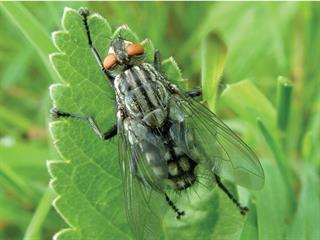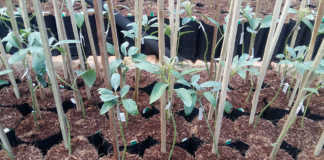
Pesticide resistance was first reported in 1914. Since then, it has been identified in more than 2 000 insect species. In 1991 alone, more than 500 species became resistant to at least one type of insecticide. There are insects resistant to just about every insecticide in current use, from organophosphates and carbamates to pyrethroids.
Resistance manifests itself in one of two ways: cross-resistance to pesticides of similar chemical structure; and, possibly more seriously, multiple resistance, where insects show resistance to unrelated pesticides. In Africa, several insect species do great damage to crops – and a number have developed pesticide resistance.
They include the diamondback moth (Plutella xylostella), the cotton leaf worm (Spodoptera littoralis) and many species of aphid. One particular aphid species, Myzus persicae, has built up resistance to no fewer than 71 different types of synthetic insecticides, while the diamondback moth is resistant to 51 chemical compounds as well as biological insecticides such as Bacillus thuringiensis (Bt).
Although the diamondback is currently the only known ‘crop pest’ resistant to Bt, other species have shown potential signs of resistance under laboratory conditions. For this reason, it is crucial that farmers who spray with Bt avoid using it for too long, to prevent resistance developing in other crop pest species.
How it develops
Any group of animals includes individuals that exhibit genetic variables (biotypes). Resistance in insects comes about when certain individuals have the ability (are genetically predisposed) to survive exposure to a pesticide that kills other individuals of that species.
Where the same pesticide is used repeatedly over a long term, the vulnerable individuals are killed off, leaving the resistant ones to flourish and become the dominant biotype. At this point, no amount of the same pesticide will work. With each successive generation, the number of insects carrying the resistant gene will increase, while those that are not resistant will die off.
Given that insects can produce large numbers of offspring over short periods, it does not take long before all the pests are born genetically resistant – and become a serious problem. Resistance can be built up in as little as two years, or it may take as long as 20 years. When DDT was introduced in the 1940s, resistance appeared within seven years.
How farmers can fight resistance
Once resistance appears, researchers have to find other chemicals and methods of controlling a particular pest. Farmers should therefore do their best to prevent resistance from occurring in the first place, or at least slow it down, by understanding the factors that contribute to resistance.
By and large, the main factor is pesticide ‘neglect’. Although insects may appear on crops, they are not all necessarily pests, and a farmer should avoid spraying automatically. Not only is this an unnecessary expense, it may do more harm than good. It is best to hold off on spraying until the pest species has reached its threshold level – the level at which the pest infestation becomes harmful to the plants.
Avoid the repeated use of the same pesticide (or one with a similar chemical make-up) over a long period. Rather rotate insecticides, making sure these are chemically different. For example, if you use an organophosphate-based pesticide, swop it for a pyrethroid pesticide, or vice versa.
Mix the pesticide according to the manufacturer’s recommendations. Making a stronger mixture will have absolutely no effect on a species carrying a resistant gene. Some people advocate mixing different pesticides together so as to inhibit resistance. This is a dodgy practice if not done carefully; the mixture could cause serious damage to the plants. Ask your fertiliser rep for advice, and if in doubt, obtain a second opinion.
Integrated pest management
Finally, a pest cannot become resistant to a predator, so encourage predators into the crop. If you are plagued by the same pest year after year, consider planting a different crop to break the insect’s reproductive cycle. Alternatively, plant crops that are more resistant to pest attack.
For help with area- or crop-specific measures, consult your agricultural extension officer.
Paul Donovan, who is based in Botswana, advises farmers on crop pest control.













